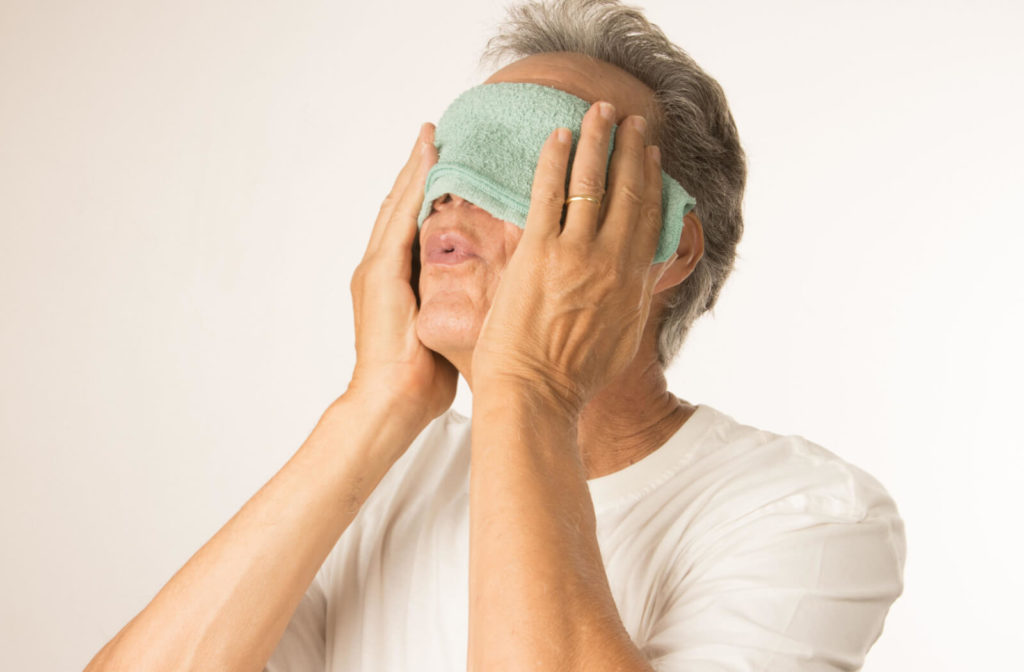Dry eyes can be irritating and uncomfortable to deal with. You may assume you need your optometrist’s help with this condition, but this isn’t always true. Did you know you can manage dry eye with a bowl, washcloth, and water?
You can use a warm compress by soaking a washcloth in warm water to help relieve dry eye symptoms and improve tear production.
What Is Dry Eye?
Dry eye is a condition where your tears cannot effectively lubricate your eyes, leading to irritation. Many people assume that dry or tired eyes are expected after a long day, and while it can happen from time to time, consistent dryness is concerning. Dry eyes are more than an annoyance—they can affect your quality of life.
You can experience several symptoms if you have dry eye, including:
- Eyes that sting or burn
- Light sensitivity
- Red eyes
- Gritty eyes
- Blurry vision
- Eye fatigue
- Watery eyes
- Trouble wearing contact lenses
- Stringy mucus in or around the eyes
What Causes Dry Eye?
Dry eye often occurs because of problems with your tear film, which includes 3 layers (mucus, water, and oil) that work together to keep your eyes clean and hydrated. When issues arise in the tear film, like decreased tear production or increased tear evaporation, it can lead to dry eyes.
Decreased Tear Production
Decreased tear production occurs when your body can’t produce enough tears to lubricate your eyes. There can be several reasons this happens, including:
- Aging
- Medical conditions
- Medication use
- Desensitized corneal nerves
Increased Tear Evaporation
Increased tear evaporation happens when your tears dry out too quickly. A common cause of this issue is meibomian gland dysfunction, a condition where the meibomian glands become clogged which can prevent proper oil flow to the tear film.
Some possible causes of increased tear evaporation include:
- Meibomian gland dysfunction
- Eyelid problems
- Eye allergies
- Vitamin A deficiency
- Preservatives in eye drops
- Infrequent blinking
How Can Warm Compresses Help with Dry Eye?
Warm compresses can help dry eyes by providing moisture and heat. These compresses can help you produce more tears, unclog the meibomian glands, and relieve pain and swelling.
Research shows that heating devices like warm compresses on the eyes can help relieve dry eye symptoms.
Are Warm Compresses Safe to Use?
Being safe with your eyes is always a good idea, so you may wonder if warm compresses can damage them.
While compresses can have many benefits, it’s important to keep the washcloth at an ideal temperature. It’s essential that your compress is warm, not hot. A washcloth that’s too hot can injure the skin around your eyes.
How to Use a Warm Compress to Manage Dry Eye
You don’t need to visit your eye doctor for a warm compress. They’re available at your home if you have the right supplies. You can make a warm compress in a few simple steps.
Use a clean bowl, washcloth, and warm water to complete the following steps:
- Fill a bowl with warm water (ensure your skin can handle the heat)
- Dunk a washcloth into the bowl until it’s completely soaked
- Take the washcloth out of the bowl and wring out the excess water
- Fold the washcloth so it fits comfortably across your eyes
Give yourself around 5 to 10 minutes to relax with your warm compress. Lie back and completely cover your closed eyes with the compress. You can use a warm compress as many times as necessary during the day—just know that frequent use may dry out the skin around your eyes.
Other Dry Eye Treatments
Warm compresses aren’t the only dry eye treatment available. Your optometrist at River Heights Eye Care has many tools to help relieve your symptoms, including at-home and in-office treatments.
Some potential treatments they may recommend include:
- Prescription eye drops: Prescription eye drops from your eye doctor can help stimulate tear production or relieve inflammation.
- Dietary changes: Dietary changes can benefit your eye health and help relieve dry eye symptoms.
- Environmental changes: Your environment can affect your eyes, leading to dryness. Changing your lifestyle and improving your environment can help your symptoms.
- Artificial tears: Artificial tears are eye drops that simulate real tears. They’re available over the counter and can help temporarily relieve dry eyes.
Don’t Live with Dry Eyes
Dry eyes don’t need to be a life-long sentence. You can improve your symptoms with at-home remedies or help from your eye doctor at River Heights Eye Care. They’re here to help you enjoy clear, comfortable vision.
Contact River Heights Eye Care if you experience dry eye symptoms.


